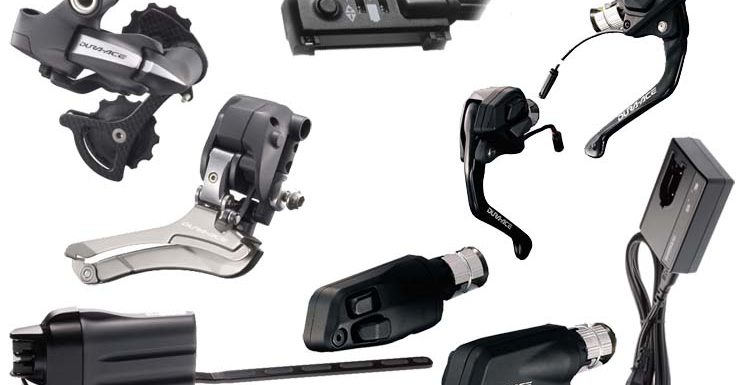
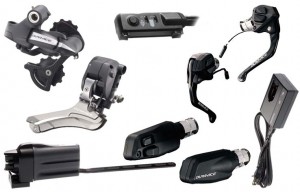 I learned quite a bit about Shimano Di2 when I installed one of the first available Time Trial/Triathlon groupsets on my Cervelo P2. I’ve subsequently answered a lot of questions on forums and article comments, and elsewhere. In doing so, I realized that people have a lot of questions about Di2 and the answers are difficult to find. This lead me to create this article, to consolidate everything I know and have been asked into one location so people can find answers. If you can’t find what you’re looking for below, please leave a comment and I’ll do my best to help.
I learned quite a bit about Shimano Di2 when I installed one of the first available Time Trial/Triathlon groupsets on my Cervelo P2. I’ve subsequently answered a lot of questions on forums and article comments, and elsewhere. In doing so, I realized that people have a lot of questions about Di2 and the answers are difficult to find. This lead me to create this article, to consolidate everything I know and have been asked into one location so people can find answers. If you can’t find what you’re looking for below, please leave a comment and I’ll do my best to help.
Index: There’s lots of info in this post, so here’s an Index to help you find specific sections:
- Di2 General Overview
- Compatibility: Between 6770 10-speed, 6780 11-speed, 9070 11-speed, first-gen 7970
- How to Check Battery Level
- How to Adjust Rear Derailleur Trim
- How to Adjust Front Derailleur Trim
- Dealer Installation Manuals
- Shimano E-tube Project Software – Change Settings and Update Firmware
- Chargers, PC USB Interfaces/Programmers
- Component Overviews
- Shift/Brake Levers
- Dedicated Shift Buttons
- Front Derailleurs
- Rear Derailleurs
- Display Units and ANT Bluetooth Wireless Communication Modules
- Batteries and Battery Mounts (Internal and External)
- Front Cable Connection A Junctions (with charger ports and LED status lights)
- Rear Cable Connect B Junctions
- Cables, Grommets, Cable Install Tools
- List of Components Needed to Build Your Own Di2 System
- Technical Details of the Di2 CANBUS protocol and signaling
System Overview: Shimano Di2 Dura-Ace 9150 and 9070 and Ultegra 6770 and 6870
The second generation Shimano Ultegra 6770/6870 and Dura-Ace 9070 “E-Tube” electronic bicycle shifting systems consist of battery-powered electric derailleurs activated by handlebar mounted push buttons. Power and shift commands are sent via a 2-wire CAN (Controller Area Network) datalink contained within a single cable housing. This design has several advantages over conventional mechanical shifting systems, the most notable of which are:
- Extremely low shifting effort, which generally results in more frequent shifts and therefore better gear ratio selection.
- Greatly improved shift quality, especially for the front derailleur chainrings, allowing shifting under full power with almost no chance of a dropped chain.
- Shifting is available at multiple positions on the handlebars, for example, at the end of the time trial aero bars, on the brake levers, up to in climbing position, and down low the sprint position.
- Automatic trimming of the front derailleur position as the rear derailleur moves back and forth between the smaller and bigger gears. This eliminates unintended contact (and noise) between the front derailleur and the chain.
- Lighter weight vs. equivalent mechanical system. The Shimano Dura-Ace Di2 9070 electronic groupset with internal battery weighs 2047 grams; the Shimano Dura-Ace 9000 mechanical groupset weighs 2074 grams (27 grams more than Di2.)
- Multi-Shift: Pressing and holding a rear derailleur shift button results in shifts through multiple gears. The rate of shifts can be configured using the PC computer interface cable and the free Shimano E-tube Project software.
- Synchronized Shifting: Starting with Dura-Ace 9150, automated Synchronized Sifting of the front derailleur is an option. Two SHIMANO Synchronized Shift modes will be available:
- Full SHIMANO Synchronized Shift: the front derailleur reacts based on the rear derailleur’s shift action. This essentially means that, when activated, there is no need for two separate shifters to control front and rear derailleurs, the two buttons on one shifter will control both derailleurs.
- Semi SHIMANO Synchronized Shift mode: the rear derailleur reacts based on the front derailleur’s shift action, shifting to the next most appropriate rear gear when the rider makes a front shift.
- R9120, R9170 – syncroshift enabled with firmware 3.2.0 or newer
- 6870, 9070 – syncroshift enabled with firmware 3.2.1 or newer
- 6770 – no syncroshift firmware update will be offered
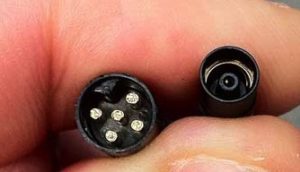 Historic Info on the older first generation 5-wire Shimano Dura-Ace Di2 DA-7970 system and how it compares to the new E-tube 2-wire system:
Historic Info on the older first generation 5-wire Shimano Dura-Ace Di2 DA-7970 system and how it compares to the new E-tube 2-wire system:
Released in 2009, the 7970 operated using a very basic 5-wire electronic system. Each shift button was connected to a different wire; shorting the specific wires together controlled the derailleur upshifts and downshifts. Because the first generation 7970 used completely different technologies than the newer 2-wire systems, none of the components are cross-compatible. At this point, Shimano is not expected to offer any updates or new components using the first generation 7970 architecture; everything from now on will be based on the newer 2-wire E-tube design. The second generation design offers several advantages, which include: 1) smaller wire size, smaller connector size, waterproof connectors; 2) all switches can be reconfigured in software to send upshift or downshift commands to either the front or rear derailleur; 3) firmware updates can add new features (such as multi-shift) and compatibility with new components.
Compatibility: Dura-Ace 9070 and Ultegra 6770 / 6870 (and old 5-conducter 7970)
The confusing naming system used by Shimano makes it difficult to figure out what each component is, much less what is compatible between systems. Here are some compatibility guidelines:
- Nothing from the first generation (4-conductor / 5-conductor) Dura-Ace Di2 7970 system is compatible with any other newer system. It was replaced by the (2-conductor) E-tube systems. No parts are inter-operable between 7970 and any other Di2 System.
- In general, every electronic Di2 component is compatible between the Ultegra 6770, 6870, and Dura-Ace 9070 systems (see exceptions below.) This means that all of the road bike Ultegra/Dura-Ace dual control brake levers/shifts, time trial shifters, and climbing shifters can be used with either Ultegra 6770/6870 or Dura-Ace 9070 front and rear derailleurs. Any of the Ultegra/Dura-Ace controllers (A Junctions) can be used with either system. All components use the same cables and connectors.
- Firmware Update Required to Make Older Components Compatible with Newer Components: If you add a new component and it doesn’t work, update the firmware using the PC USB adapter and the Shimano E-tube Project Software for Windows.
- Synchronized Shifting and Bluetooth Wireless Units can be added to all E-tube Ultegra and Dura-Ace systems but the battery has to be upgraded to the BT-DN110 Internal Battery or BM-DN100 External Battery Mount. To add Bluetooth capability, a EW-WU101 or EW-WU111 inline transmitter must be added to road bikes and for mountain bikes, the SC-MT800 or SC-M9051 display/transmitter unit must be added.
- Compatibility Exceptions:
- Note 1 – Sprint Shifter Exception: The Sprint Shifter is the only exception for shifter incompatibility. It has a different wiring connector (and internal components) that can only plug into a unique/dedicated third port on the Dura-Ace ST-9070 Dual Control Brake Levers/Shifters and also the ST-6870 Levers. There is no sprint shifter port on the ST-R785 Hydraulic Levers.
- Note 2 – Can’t mix 10-speed/11-speed front/rear Derailleurs: It is no longer possible to use a 10-speed front derailleur with an 11-speed rear derailleur (and 11-speed front with 10-speed rear.) See note farther below to read the history on this if you want all the messy details.
- Note 3 – Front A junction and Internal Battery: Since the February 2015 firmware update, the older SM-EW67-A-E Front Junction A is no longer compatible with the BTR2 Internal Battery because it does not have the charging port to charge the internal battery. The SM-EW90 Front Junction (with integrated charging port) should be used instead. The SM-EW67 still works with the external battery.
- Note 4 – Update the Firmware to make components compatible: If the firmware on all components is not updated to the latest version, some components may be not operate correctly with one another. So download the latest E-tube software and update everything and it should work.
- Note 5 – All Shifters work with all 10-speed and/or 11-speed Rear Derailleurs: All of the shifters are compatible with either the 10-speed Ultegra 6770 or 11-speed Ultegra 6870/Dura-Ace 9070 systems as long as they all have the latest firmware. The rear derailleur is the only component that “knows” or “cares” how many rear gears are available. The shifters only send upshift/downshift commands and do not “know” or “care” which gear is currently selected and how many total gears there are.
- Note 6 – SM-BTR1 External Battery and SM-BMR1 Mount firmware updates: The more expensive dedicate service tool (SM-PCE1 PC Interface) must be used to upgrade the firmware on the external battery/mount.The external battery and battery mount can not receive firmware upgrades via the SM-EW90 Front Junction A and the SM-BCR2 PC Interface/Battery Charger. (The SM-EW90 will work in a system with an external battery, but a firmware update can cause them to become incompatible until both are updated independently using the appropriate PC Interface and the Shimano E-Tube Project software.)
- See the Shimano E-tube compatibility chart version 3.4.3 for more details
Compatibility: 11-Speed Rear Derailleur and 10-speed sprockets/wheels
The 11-speed Dura-Ace 9070 and Ultegra 6870 rear derailleurs are designed exclusively for 11-speed rear sprockets and 11-speed Front Derailleurs. Shimano does not provide a way to recalibrate/reprogram them for a 10-speed setup. The sprocket spacing is slightly smaller and the overall range of travel slightly longer on 11-speed systems. If you have 10-speed wheels and 10-speed sprockets, you should use the 10-speed RD-6770 rear derailleur and a 10-speed FD-6770 front derailleur.
Similarly, a 10-speed RD-6770 rear derailleur should not be used with 11-speed sprockets. There will be chatter in some gears, and there might be slow-shifts or self-shifts.
It doesn’t matter which shifters are used; the shifters send upshift/downshift commands regardless of which derailleur config is being used. Shifters do not “know” or “care” which gear is currently selected and how many total gears there are.
Front Chain Rings: In general, most any front chain rings will work, rigid forged rings work best with Di2 due to high front derailleur shift forces. Shimano chain rings tend to be the best, but most others work as well. A 10-speed specific or 11-speed specific chain should be used, but the differences between them are minimal and can generally be mixed/matched without issue.
How to convert “non-upgradeable 10-speed only” wheels such as Zipp 900/Sub9 Disc Wheels to 11-speed: “the spacing between a Campy 11 and Shimano 11 is close enough that you can use the cassettes interchangeably. If you get a Campy free hub body, the 2 shims (part# is on the Zipp website, just search for Campagnolo 11) and a Campy cassette and you’re ready to ride with all 11 cogs available to use.” via slowtwitch.com
But it’s an emergency and I need to use a 10-speed wheel. . . In emergency situations, 11-speed rear derailleurs can be used with 10-speed sprockets. There will probably be chatter in some gears, and there might be slow-shifts or self-shifts. To setup an 11-speed rear derailleur for a 10-speed sprocket setup, adjust the mechanical limit screw so that it can’t shift into the missing 11th sprocket position, then follow the rear derailleur adjustment procedures listed below.
Included for very motivated individuals only: 10-speed front derailleurs can be used with 11-speed rear derailleurs if the shifters and battery have firmware installed from E-tube software version 2.5.2 or earlier. Shimano disabled support for this 11-speed and 10-speed cross-matching with later firmware updates. For informational purposes only, the details of how to regain compatibility are detailed below.
- Important Notice 2014-07-14: There is a compatibility issue with Shimano e-Tube software/firmware versions v2.6.0 and later that prevents 10-speed front derailleurs (FD-6770) from working with 11-speed rear derailleurs (RD-6870) and 11-speed front derailleurs (FD-6870) from working with 10-speed rear derailleurs (RD-6770). DO NOT UPDATE FIRMWARE using Shimano e-Tube software v2.6.0 or later if you are mixing an FD-6770 front derailleur and a RD-6870 11-speed rear derailleur, or a FD-6870 with a RD-6770.
- The problem component is the battery (external battery mounts SM-BMR1 and SM-BMR2, internal seat post battery SM-BTR2.) If you keep battery firmware at v2.0.6 or earlier, the system will continue to function properly. Shimano e-Tube Software v2.6.0 will update battery firmware to v3.0.5, and will not allow the RD-6870 to work with a FD-6770 setup.
- If the battery firmware is updated to 3.0.5, it CAN NOT be rewritten back to the older version. You will need to need to replace a derailleur so that both are 6770 10-speed or so that that both are 6870 11-speed. (The other option is to get get a battery with the older firmware and never update it.)
- Here’s a link to the “last known good version” of the Shimano e-Tube software to work with a mixed 10-speed/11-speed system: E-tube_Proj_V_2_5_2.zip Use this version and do not connect to the internet when using it so that E-tube can’t check for updates when open.
- To roll-back newer versions of battery and shifter firmware, install E-tube version 2.5.2 and made a copy of “C:\ProgramData\E-tube Project\FW” which has all the firmwares packaged in that version of E-tube. Next, install the latest version of E-tube. Then copy all the firmwares from the the 2.2.3 version back to the same location “C:\ProgramData\E-tube Project\FW” for the latest version (note: ProgramData is a hidden directory, click here for details on how to view it.). Next, the trick is to find the firmware you want to downgrade (pretty easy from the name and version in the file name), and then rename it to the same name as the latest version, but increment the last version digit by one. Then connect to the bike with E-tube (without an internet connection) and it will identify that a firmware upgrade is available for that component and allow you to do the firmware “upgrade” to the older version of firmware. Now exit E-tube and then rename the firmware file back to original to prevent the issue in future. E-tube will then try to upgrade again but just don’t let it do that. This should get a bike that did nothing (not even enter adjustment mode) to a fully working state by reverting the battery and shifters. Running latest firmware in derailleurs seems to be fine. (thanks to commenter vosadrain)
- It will not be possible to charge the BTR2 internal battery using the BCR2 USB charger unless you also downgrade the firmware of the BCR2 USB charger as well.
- Note however that latest E-tube software will say the setup is unsupported and will not allow programming. To do programming, disconnect the internal battery and connect a spare external battery. This allows making settings changes. To program the BTR2 itself, I just connect to the BTR2 by itself (no other components) and the E-tube software will allow firmware changes to it. Or try using the 2.5.2 version of E-tube.
- Alternatively, buy a Di2DIY internal seat post battery kit and you will not have to go through the firmware downgrading. The kit makes it possible to run all components with the latest E-tube firmware. Also worth noting some firmware updates were done to fix power distribution errors in the FPGA’s that would allow the batteries to drain down when the bike was just sitting.
Checking Battery Charge Level:
A single battery charge should give at least 1500 miles of riding. Most riders will not need to charge the battery more than twice a year.
To check the battery charge remaining, press and hold any shifting switch for 0.5 seconds or more. The amount of battery charge remaining will be indicated by the light on Front Controller A Junction.
- 100% remaining: Illuminates green (for 2 seconds)
- 50% remaining: Flashes green (5 times)
- 25% remaining: Illuminates red (for 2 seconds)
- 0% remaining: Flashes red (5 times)
When the battery charge is low, first the front derailleur will stop operating, and then the rear derailleur will stop operating. When the battery charge has been fully spent, the derailleurs will be fixed at the last gear shifting position. If the battery indicator is illuminated red, it is recommended that you recharge the battery as soon as possible.
Adjusting the Rear Derailleur Trim:
If you switch between multiple rear wheels, it’s very likely that the sprockets on different wheels won’t be in exactly the same relative position to the rear derailleur, resulting in that annoying clicking sound as the chain makes contact with an adjacent sprocket. Follow the steps below to properly align the rear derailleur with the rear sprockets.
- Shift the rear derailleur to the 5th sprocket position. Press the button at the junction (A) of the SM-EW67-A-E until the red LED illuminates in order to switch to rear derailleur adjustment mode. Note that if you keep pressing the button after the red LED has illuminated, protection recovery operation will begin.
- If shifting switch is pressed once while the initial setting condition is active, the guide pulley will move one step toward the inside. If shifting switch (Y) is pressed once, the guide pulley will move one step toward the outside.
- Note: The guide pulley can move 15 steps inward and 15 steps outward from the initial position, for a total of 31 positions.
- Note: When adjusting, the guide pulley will overrun slightly and then move back in an exaggerated movement so that you can check the adjustment direction. When checking the positions of the guide pulley and the sprocket, check at the position where the guide pulley finally stops.
- While turning the front chainwheel, operate shifting switch to move the guide pulley toward the inside until the chain touches the 4th sprocket and makes a slight noise.
- Next, operate shifting switch 4 times to move the guide pulley toward the outside by 4 steps to the target position.
- Press the button at junction (A) until the red LED turns off in order to switch from rear derailleur adjustment mode to gear shifting mode. Shift to each gear and check that no noise is generated at any gear position. If fine adjustment is needed, switch back to adjustment mode and readjust the rear derailleur.
- Note: if you have customized your shifters and swapped buttons, this will change which shifter and buttons control the micro-adjustments. Also, if you hit the wrong buttons while trying to set the FD trim, you can actually alter the setup of your RD. Be certain that you’re hitting the correct adjustment buttons.
- If you have a Garmin or similar head unit and a SM-EWW01 ANT module, the display will automatically switch into derailleur trim display when you activate that mode (i.e. by pressing the button at the junction (A) of the SM-EW67-A-E.) It will give you the trim position in either + or – 12 positions. When switching wheels, simply take note which position suits which wheel/sprocket/trainer, and trim to that level each time you change. This removes the guesswork and makes changing from wheel to trainer simple.
Note on FD-6870 Front Derailleur Trim:
The FD-6870 trim adjustment effects the auto-trim positions. The adjustment feature is accessible via either the A-Junction box, or the “Front derailleur adjustment setting” in the e-tube software, and should be used only after you have already set the physical inner/outer limit screws. So for example, if the FD outer plate rubs the chain when using the 6th largest cog, you would want to adjust the FD trim outward a couple ticks. However, you can only perform this adjustment while in the big-ring/big-cog combination. Etube forces the derailleurs into this maximum cross-chained position, whereas during the manual method you must shift to these positions yourself. (Thanks to commenter Bryan B for the info.)
Dealer Manuals:
The dealer’s manuals contain the most detailed information available from Shimano. If you’re looking for detailed installation instructions, check here:
- Shimano Ultegra 6770 Dealer’s Manual: http://techdocs.shimano.com/media/techdocs/content/cycle/SI/Ultegra/UltegraDi2/6770Di2_DM_EN_v1_m56577569830773882.pdf
- Shimano Ultegra 6870 Dealer’s Manual: http://si.shimano.com/php/download.php?file=pdf/dm/DM-UL0001-00-ENG.pdf
- Shimano Dura-Ace 9070 Dealer’s Manual: http://si.shimano.com/pdf/dm/DM-DA0001-00-ENG.pdf
- Shimano Alfine Di2: http://si.shimano.com/php/download.php?file=pdf/dm/DM-AL0001-03-ENG.pdf
Shimano E-tube Project Configuration and Firmware Update Software for Windows:
Shimano E-tube Project Wireless for iOS and Android: Announced on April 15, 2016 but as of yet unreleased, these apps will allow configuration of shift profiles (multi-shift on/off, multi-shift delay between shifts, shifter button assignments) and firmware updates over Bluetooth. To function, a Shimano Di2 Bluetooth Adapter, such as the MT800 digital display, is required.
Shimano E-tube Project Windows PC Software: This free software is used to update the firmware of all components. It works with the SM-BCR2 Charger + USB Adapter and the SM-PCE1 Diagnostic Adapter. The software is used to change the configuration of each shift button / lever (any can be programmed to upshift or downshift either the front or the rear derailleur.) It can also be used to enable multi-shift (multi-shift is where the shifter is held and the rear derailleur shifts through multiple gears until the shifter is released.) The delay between of the gear changes during multi-shifting can also be adjusted. The software is available from http://e-tubeproject.shimano.com/
Older versions of the e-tube software are available from these links: 2.5.2
PC & Mobile Interfaces, Chargers, and Software:
SM-BCR1 Battery Charger: This is used to charge the external battery. The part number for the battery charger wall cord is SM-BCC1.
SM-BCR2 Charging and PC Connection: for SM-EW90-A 3-port and SM-EW90-B 5-port A Junctions. This plugs into a special port on the side of the A junctions (which is covered by a rubber flap.) This adapter charges the internal battery when first plugged into the A junction; it must be powered by a standard USB Wall charger (such as that used for an Apple iPhone) or a PC that is powered-on. If the Shimano E-Tube Project Software is launched on the Windows PC with the SM-BCR2 attached, the SM-BCR2 will switch from charging mode to configuration mode. It must be detached from the computer and reattached to switch back to charging mode.
- It takes about 2 hours to charge the internal battery.
- Amber light=charging.
- Light turns off when done.
- If the Amber light does not come on when plugged in, this indicates battery is not discharged enough to charge.
- Light flashing indicates something is wrong, like trying to charge a external battery through a BMR.
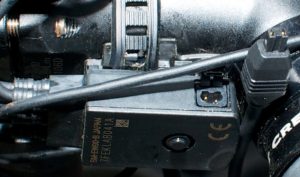
Hacking the SM-BCR2 to have a standard Di2 cable connector: If your 3-port or 5-port junction is inaccessible for charging, there is an alternative hack method to connect it to the system through a standard Di2 port. With basic soldering skills you can hack the BCR2 to be used with any setup. Buy any length EW-SD50 wire, cut off one end. Cut the wire on the output side of the BCR2. Splice the two wires together, so that the output wire of the BCR2 is now a standard Di2 connector. The charger has an inner (white) and outer (shield) wire; connect the inner white wire to the SD50 red wire; connect the charger outer shield wire to the SD50 black wire. You will then be able to plug the BCR2 into any Di2 port. Or use a SM-JC40 junction B and another length of EW-SD50 wire and go through the RD (by using the SM-JC40 to connect the rear derailleur, new output wire of the EW-SD50, and the wire that ordinarily connect the rest of the system to the rear derailleur.) Thanks to @Di2diy for the info.
SM-PCE1: This PC Configuration and Diagnostics adapter will not charge the internal battery. It offers the same configuration options as the SM-BCR2, but also add some advanced diagnostic and troubleshooting features that the SM-BCR2 does not have. It attaches to via the standard E-tube wire (just like the EW-SD50 cables) rather than to a dedicated port on the side of the front A junction.
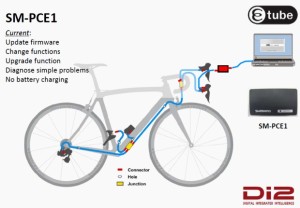
Bluetooth and E-tube Apps for Apple iOS and Android: Bluetooth wireless modules are available to allow system settings to be adjusted via the mobile applications that connect via Bluetooth Adapters.
Component Overview:
The confusing naming system used by Shimano makes it difficult to figure out what each component is, much less what it does and how it fits into an a complete Di2 system. Here’s an overview of all the major Ultegra and Dura-Ace Di2 components.
Dual Control Brake Levers/Shifters (a.k.a. Brifters):
ST-6770 Ultegra Road Dual Control Brake Levers/Shifters: The Ultegra version can be used with the climbing shifters. They are sold in in left/right pairs and are also available separately.
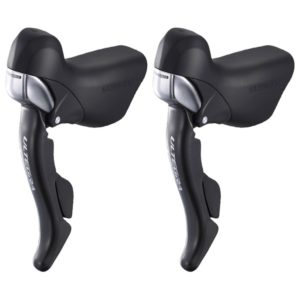
ST-9070 Dura-Ace Road Dual Control Brake Levers/Shifters: The main advantages these have over the ST-6770 version is slightly lighter weight and compatibility with the low-mount sprint shifters. As like the Ultegra version, they are compatible with the climbing shifters. They also have hidden button under the rubber hoods that can activate screen changes on cycling computers from Garmin, Magellan, Pioneer, and Shimano (Shimano SM-EWW01 ANT Wireless Broadcast Module required.)
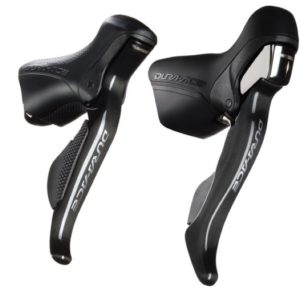
ST-9071 Dura-Ace Time Trial/Triathlon Dual Control Brake Levers/Shifters: These levers provide shifting from the pursuit bar position on time trial bikes. There is no Ultegra option offered at this time. These are available as left/right pairs, or can be ordered separately. These do have a permanently attached wire with a male end for connection the the SM-EW90 front “A” junction. Combined weight both levers: 117 grams.
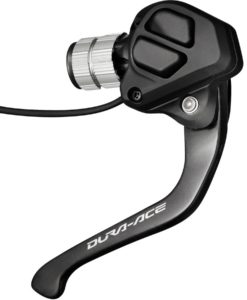
ST-R9160 (standard cable brakes) and ST-R9180 (hydraulic brakes) Time Trial Dual Control Brake Levels/Shifters: These are the lower-profile shifters offered with the newer Dura-Ace R9150 groupset.
ST-6871 Ultegra Time Trial/Triathlon Dual Control Brake Levers/Shifters: Ultegra version of the ST-9071 Dura-Ace shifters. Slightly heavier and much less expensive than the Dura-Ace version. Combined weight both levers: 142 grams.
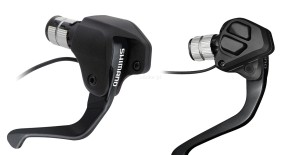
ST-R785 Hydraulic Road Dual Control Brake Levers/Shifters: These hydraulic road shifters are compatible with both the climbing and sprint shifters. These are compatible with the SM-RT99 centerlock 140mm and 160mm rotors and WH-RX31 wheelset (which as no standard rim brake track.) These require the BR-785 dual piston hydraulic disc calipers. They do not have the special wiring port required for the SW-R610 Sprint Shifters and a SM-EW90-B 5-port junction A is required to use the SW-R600 climbing shifter.
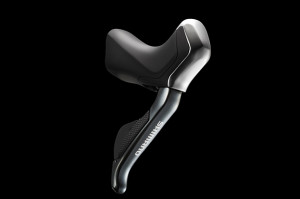
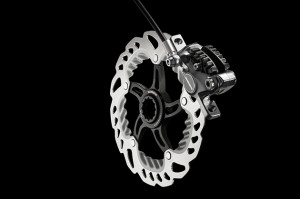
ST-6870 Ultegra Road Dual Control Brake Levers/Shifters: These road shifters are compatible with both the climbing and sprint shifters.
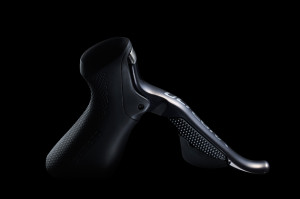
Dedicated Shifters:
SW-R671 Dura-Ace 2-Button Time Trial/Triathlon Bar End Shifters: These shifters are installed on the end of time trial aero bars. By default, the left shifter upshifts/downshifts the front derailleur; the right controls the rear derailleur. For both, the lower button upshifts into a harder gear and the upper button downshifts to an easier gear. This can be changed using the Shimano E-tube Project software; the functions of the left and right sifters can be switched with one another as well. These are available in pairs or separately.
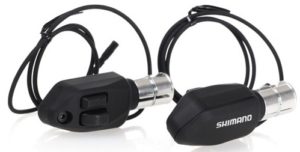
SW-9071 Dura-Ace 1-Button Time Trial/Triathlon Bar End Shifters: These shifters have only one button each and are intended to control only the rear derailleur, with one sending the upshift command and the other the downshift command. (I personally think this version is absolutely worthless. Why have 2 SW-9071 shifters at twice the price and twice the weight, when you can just buy a single SW-R671 Right shifter instead.)
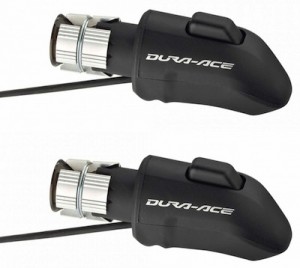
SW-R600 Climbing/PAVE Shifter: This shifter is for road bikes and is mounted on the upper horizontal portion of the handlebar, or any other location comfortable for the rider. They can be used in addition to the Dual Control Brake Lever/Shifter, or can be used on their own by plugging directly into a SM-EW90-A 3-Port Junction or SM-EW90-B Dura-Ace 5-Port Junction.
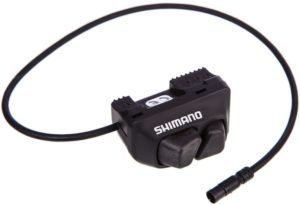
SW-R610 Dura-Ace Sprint Shifter: This is the only component using a unique wiring connector; it is only compatible with the ST-9070 Dura-Ace and Ultegra ST-6870 Road Dual Control Brake Levers/Shifters. Unlike all of the other shifters, the sprint shifters do not contain a circuit board; they do not show up as components on the CAN bus network. Instead, the sprint shifters are simple momentary switches that activate the circuit board on the host Dual Control Brake Lever/Shifter. The host dual control lever is what sends the shift command. (Note: Any momentary switch can be attached to the sprint shifter port on the Dual Control Levers by splicing into a standard EW-SD50 wire to act as remote shifters.)
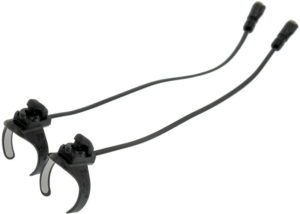
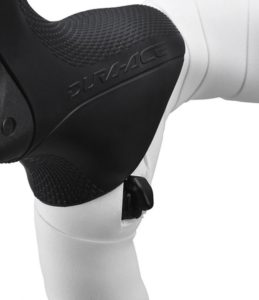
Alfine SW-S705 Right Flat-Bar Shifter: Reported to work with other non-Alfine setups.
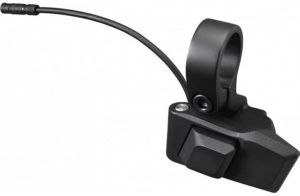
SW-R9160 Time Trial bar-end shifters (pair): These are-end shifters directly control the rear derailleur, with one for the upshfit and one for the downshift. The front derailleur is controlled automatically via automatic Synchronized Shifting. These shifters require the BT-DN110 Internal Battery for synchronized shifting.
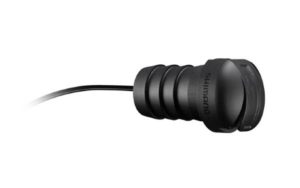
SW-R9150 Climbing shifters (pair): These tiny climbing shifters are about as small as the sprint shifters, but can be directly connected to a junction box and do not have to be connected as slave buttons to a brake/shift lever special port. They come with plastic mounts to make it easier to attach to bars beneath bar tape. They are ideal for synchronized shifting, with one controlling the upshifts and the other downshifts. These shifters require the BT-DN110 Internal Battery for synchronized shifting.
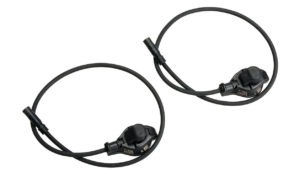

Front Derailleurs:
FD-6770: Ultegra Front Derailleur
FD-6870: Ultegra Front Derailleur, pretty much identical to the FD-6770 but with a slightly larger diameter adjusting screw (to better dissipate the shifting forces).
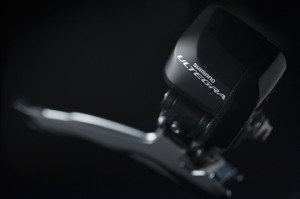
FD-9070: Dura-Ace Front Derailleur
FD-R9150: Dura-Ace Front Derailleur for 9150 systems; features slightly reduced weight vs. 9070.
Rear Derailleurs:
RD-6770: Ultegra 10-Speed Rear Derailleur, compatible with gears up to 28 teeth.
RD-6870: Ultegra 11-Speed Rear Derailleur, compatible with gears up to 32 teeth (for the GS version).
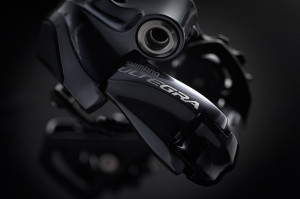
RD-9070: Dura-Ace 11-Speed Rear Derailleur, lighter weight version on which the RD-6870 is based.
RD-R9150: Dura-Ace 11-Speed Rear Derailleur with 30-tooth sprocket compatibility and modified “Shadow RD” geometry to keep the mechanism close to the rear wheel to help avoid damage in the event of an accident.
Alfine SG-S505 and SG-S705: The Shimano series targets comfort and urban bikes. It uses an 8-speed (505) or 11-speed (705) internal epicyclic rear hub. It is believed to be compatible with other Di2 ETube components but this has not been verified.
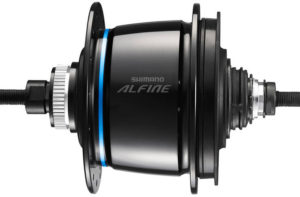
Display / Wireless Communication:
SM-EWW01 ANT Wireless Broadcast Module: This module wirelessly broadcasts Di2 data (front and rear gear selection details, gear ratio, battery life) to a cycling computer using the ANT protocol. It is compatible with Dura-Ace 9070, Ultegra 6870 Di2 and Ultegra 6770 E-tube road shifting systems. SM-EWW01 plugs into the E-tube wiring system between existing components. It has an 2 wiring ports, so it can be connected between a front shifter and the Front Junction A, or at the rear derailleur (between rear derailleur and Etube wire.) It transmits through a proprietary private ANT wireless protocol, which may eventually become a standard public ANT+ protocol. It is powered by the same Di2 system battery. It is currently compatible with the Garmin Edge 1000, Mio 505, and the PRO SCIO cycling computers (with more to come.) The hidden buttons under the hoods of the 9070 shifter levers will switch screens on the cycling computer when paired with this module. It does not currently allow for shifting control from a cycling computer/device and it is not clear that this functionality will ever be offered. The SM-EWW01 is 38mm long, 25mm wide, 12.5mm high, and weighs less than 5 grams. It does not come with any wires; 1 wire would have to be added if adding this module to an existing Di2 system.
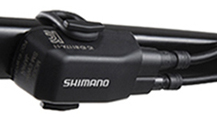
EW-WU101 and EW-WU111 ANT and Bluetooth Wireless Broadcast Modules: These modules are similar to the SM-WEE01 but also include Bluetooth capabilities in addition to ANT capabilities. They require the BT-DN110 battery or the BM-DN100 Battery Mount and cannot be used with the SM-EW67 Front A Junction.
SC705 Alfine Display Unit: This unit displays the battery level and the rear derailleur gear selection. It is powered by the system battery and has a port for the SM-BCR2 internal battery charger / USB diagnostic tool. It is primarily designed for Alfine systems (both 8 505-series and 11 speed 705-series). It is compatible with Ultegra and Dura-Ace Di2.
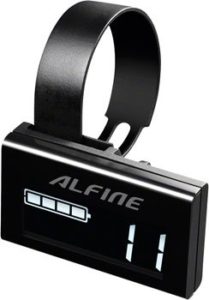
MT800 Digital Display with Bluetooth: Primarily aimed at XT mountain bike applications, this display allows toggling between the 3 synchronized shift modes (where both derailleurs are intelligently coordinated in unison by one pair of buttons, so no need for discrete shifting of the front derailleur.) It also shows battery level, gear position, shift mode and FOX iRD suspension position. The Digital Display required the new BT-DN110 battery. Existing Di2 XT systems are upgradable to be compatible with the new digital display after battery upgrade and firmware upgrade. This display has 3-port Di2 Cable junction and charging port integrated into the back and serves as a Front A Junction.
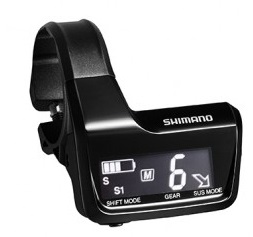
Batteries and Battery Mounts:
The batteries contain the main controllers for the system. It is therefore required to upgrade the battery to get features released in new versions of Di2 (such as Synchronized Shifting that automatically controls the front derailleur based on rear derailleur shifting.)
SM-BTR1 External Battery: This external battery must be used with the SM-BMR1 battery mount. It is removed from the mount and charged using a dedicated charger.
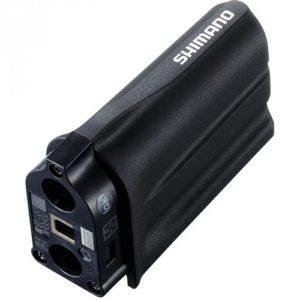
SM-BMR1 and SM-BMR2 External Battery Mount: This mount attached to bottle cage mount points or other dedicated frame mounts. It is available in 3 different mount lengths: -I (intermediate length), -S (short length), -L (long length). The SM-BMR2 is an updated version of the SM-BMR1.
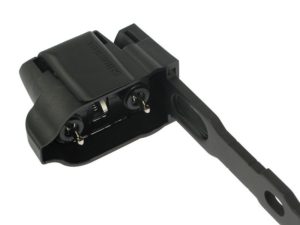
SM-BTR2 Internal Battery: This battery is typically mounted in the seat post or seat tube of the frame. It is charged by plugging the SM-BCR2 Charging Cable/PC Adapter into the SM-EW90-A or SM-EW90-B Front A junctions.
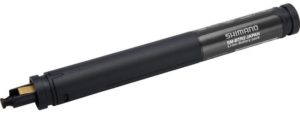
BT-DN110 Internal Battery: This battery is required for Bluetooth wireless units and road groupset Synchronized Shifting functionality.
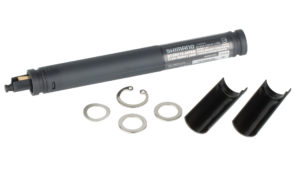
BM-DN100 External Battery Mount: This battery is required for Bluetooth wireless units and road groupset Synchronized Shifting functionality.
Front A Junctions:
SM-EW67-A-E Ultegra 3-Cable Junction: This is the original front junction with 2 integrated cables to connect to the dual control brake lever/shifters. The male cable ends on this Front A Junction will not mate directly to the male cable ends on any of the Time Trial/Triathlon dual control brake shift levers or shifters; SM-JC41 Rear B Junctions can be used to connect this front A junction to TT/Triathlon shifters. This Junction works only with External Batteries, not Internal Batteries.
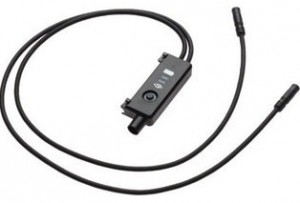
SM-EW90-A Dura-Ace 3-Port Junction: This front “A” junction is most commonly used in road bike setups. 2 ports connect to the dual control brake / shift levers; the third port is for the cable that leads to the bottom bracket junction.
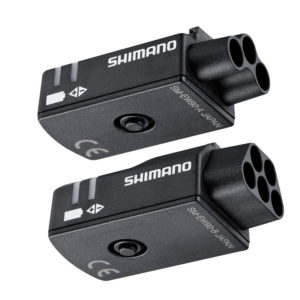

SM-EW90-B Dura-Ace 5-Port Junction: This front “A” junction is primarily used in the Time Trial / Triathlon setups. 2 of the port are for the brake/shifter dual control levers, 2 of the ports are for the aer0 bar bar-end shifters, and the 5th port is for the cable that runs to the bottom bracket (where the B junction joins the wires from the front A junction, front derailleur, rear derailleur, and battery.)
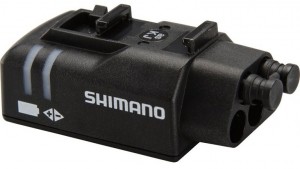
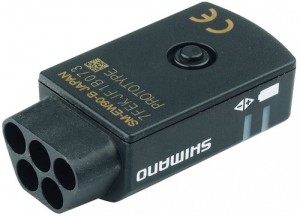
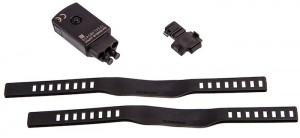
EW-RS910 Internal Bar-end Junction: This junction is installed into the end of a bar or in a dedicated frame port. It facilitates internal cable routing.
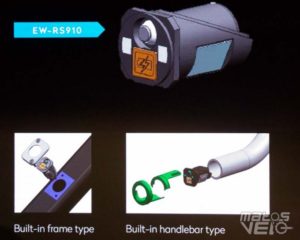
B Junctions:
SM-JC41 Internal Junction: This version has the exact functionality as the SM-JC40 external version, but doesn’t have the mounting tab for being bolted to the bottom bracket or wrapping the extra cable lengths. It has 2 ports on one end and 2 on the other, making it more compact. In addition to being located at the bottom bracket to connect the A junction, battery, front derailleur, and rear derailleur, it can be used at the handle bars to join multiple shifters prior to being connected to the A Junction.
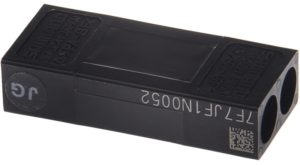
SM-JC40 External Junction: This version is intended to be attached to the frame using the bolt that is commonly located underneath the bottom bracket housing. This junction contains no electronics; it’s sole purpose is to join 4 connectors together, which are usually the wire from the front A junction, the battery, the front derailleur, and the rear derailleur. There are wire holders above the housing to capture the extra wire length by wrapping it back-and-forth.
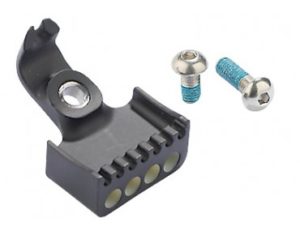
Cables, Grommets, and Cable Remove/Install Tool:
EW-SD50 Cables: These cables connect the front A junction, the battery, the front derailleur, and the rear derailleur to the rear B junction, which is typically located near the bottom bracket (near the cranks.) These are available in lengths of 300mm, 350mm, 400mm, 500mm, 550mm, 600mm, 700mm, 750mm, 950mm, 1000mm, 1200mm, 1400mm.
SM-GM01 Grommet: These round grommets are used when drilling round holes for internal cable routing, or with existing round holes. The required hole diameter is 6mm (6mm = .236 inches. Use a 7/32-inch drill bit and then “wallow-out” the hole to make it a little bigger; a 1/4-inch drill bit will work but is just slightly larger than necessary.)
SM-GM02 Grommet: These 7mm x 8mm oval shape grommets are used in some situations / frame designs.
Shimano TL-EW02 Ultegra DI2 E-Tube Tool: This tool is used to connect and disconnect the Etube wires. They are extremely difficult to connect/disconnect by hand, and pliers or other tools can damage the wires. Don’t get this confused with the TL-EW01 tool, which is for the older 5-wire 7970 cables. (My Dura-Ace TT Dual Control Levers came with one of these tools, but no other components did.)
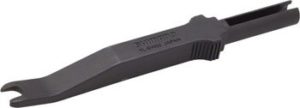
Common Questions (via Shimano):
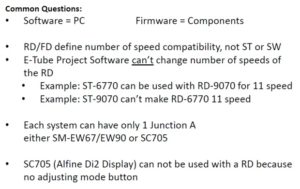
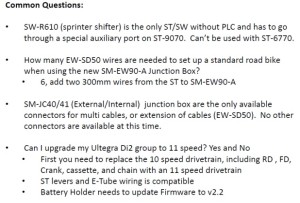
Note: it is not necessary to replace the FD from upgrading from 10-speed to 11-speed.
What Components do I need to put together my own Di2 system?
Because of the huge number and variety of components, it’s very difficult to figure out what is actually necessary and what is optional. So here is a list, for the setup I recommend: Ultegra 6870. It starts from the handlebars and works backwards. (This assumes both front and rear derailleurs, but you actually don’t have to have both; you can pick one or the other and only the corresponding front shifter to go along with it.)
- Any Type of Shifters / Shift Buttons. The Dual Control Brake Levers/Shifters are not required. You can get the just the climbing shifters or Triathlon/TT bar-end shifters, and then potentially add the Dual Control Levers/Shifters at a later point. (The only exception is the Sprint shifters, which require specific Dual Control Levers/Shifters with special ports as noted elsewhere in this article.) Amazon.com link
- EW-SD50 Wires 1 and 2 between the front shifters and the Front Junction A (0nly for some shifters). This is a bit confusing, because some of the front shifters come with wiring attached to them and some of them require purchasing separate wires. In general, most of the stand-alone shifters come with wiring, as do the TT/Triathlon dual control shifters/levers, but the road dual control levers do not. Amazon.com link
- Front Junction A. I recommend the SM-EW90-B 5-port front junction A as it provides the most upgrade flexibility; get the 3-port option only if you’re positive you’re never going to add more shifting components. The older SM-EW67-A-E has 2 wires built-in to connect with each of the dual control shift/brake levers; it doesn’t offer much flexibility or compatibility with a TT/Triathlon setup or adding additional shifters. Amazon.com link
- EW-SD50 Wire 3 between the Front Junction A and the 4-port Rear Junction B connector. Amazon.com link
- EW-SD50 Wire 4 between the Rear Junction B and the Front Derailleur. Amazon.com link
- EW-SD50 Wire 5 between the Rear Junction B and the Battery. Amazon.com link
- EW-SD50 Wire 6 between the Rear Junction B and the Rear Derailleur. Amazon.com link
- Rear Junction B: This is where the wire from the front of the bike is connected to 3 output wires leading to the front derailleur, rear derailleur, and battery. SM-JC40 is for external wiring, SM-JC41 is for internal. Amazon.com link
- Grommets for any place where the wire goes into the frame through a drilled hole. Amazon.com link
- Front Derailleur. I recommend the Ultegra FD-6870 for 11-speed builds or the FD-6770 for 10-speed builds. The Dura-Ace FD-9070 is pretty much identical, just slightly (41g) lighter and 11-speed only. (I do not recommend the Ultegra FD-6770 unless you have a 10-speed setup, because of firmware compatibility issues with 11-speed rear derailleurs. Also, it is an older design than the FD-6870, so it is larger and offers slightly less shifting force.) Amazon.com link
- Battery and Charger. Internal or external, depending on the build. If you have to skill/time/money-to-pay-someone to get everything internal, I highly recommend that option. The SM-BTR2 internal battery has more advanced integrated electronics and is better for firmware upgrades with the SM-BCR2 internal battery charger/PC tool. If you go with the SM-BTR1 external battery, you will need the SM-BMR1 external battery mount and SM-BCR1 external battery charger. Amazon.com link
- Rear Derailleur. I recommend the Ultegra RD-6870 for a new build if you have 11-speed compatible wheels with 11-speed sprockets, or the Ultegra RD-6770 if you have 10-speed wheels/sprockets. The system must be match front and rear derailleurs (both 6870 11-speed or both 6770 10-speed.) Amazon.com link
- TL-EW02 Etube Wire Remove/Install Tool: It takes quite a bit of force to snap the wires in/out. You may think you can get it seated properly with just your fingers, only to then have the wire come loose because it wasn’t fully seated. It’s a good idea to keep one in your saddle bag. Amazon.com link
What wire lengths do I need? This question is impossible to answer correctly, as it’s highly dependent on the frame size and configuration. What I recommend is running string between the component mounting locations to measure the lengths. Be sure to add some extra length, as I find that wires seem to come up short pretty frequently, even when “adding a little extra” to start with. Nothing is more frustrating that having a wire that is 25mm too short. I recommend ordering a few extra wires of multiple lengths and then returning the unneeded/unused wires. As noted above, the standard wire lengths are 300mm, 350mm, 400mm, 500mm, 550mm, 600mm, 700mm, 750mm, 950mm, 1000mm, 1200mm, 1400mm. Do not cut/splice these wires; the connectors on the end of the wires are very small in diameter to start with and you’ll end up with a splice that is larger and less waterproof than you started with.
Acknowledgements: Special thanks to Di2diy for his continued help in the comments. Check out his Ebay store for custom Di2 batteries, harnesses, and components.
Technical Details of the Di2 CANBUS protocol and signaling
Thanks to commenter Ghislain for the details: “I reversed engineered the signal going to the RD. Since I did not have a special tap connector, I could only look at the actual signals in open loop (RD wire disconnected) on the wire going to the RD using an oscilloscope. First, I found that shift up and down are multiplexed on the same wire. A shift down would generate a positive 100 msec clean 8 volt pulse (varies between 50 msec to 500 msec depending on how long you hold the shifter). On the same wire, a shift up would generate a series of 2 msec pulses that would last the same time of a shift down pulse. Therefore, the RD has enough intelligence to discriminate between the 2 types of pulses. When you hold the button on junction A, a 140 msec pulse is generated. But since my RD wire was disconnected, the RD would not go in adjust mode.”
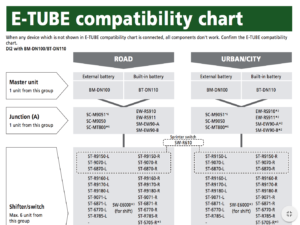
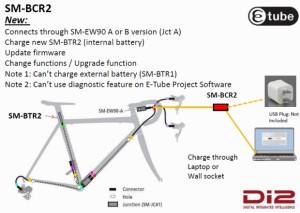
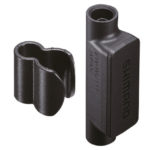
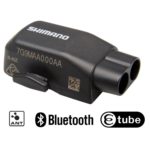
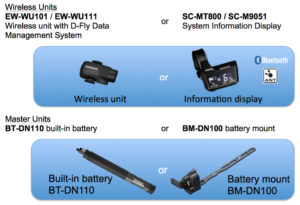
Hi Carlton – excellent info. Thanks
9070 DI2 question. What could be damaged if someone triggers a shift by accident while the bike is stationary meaning the chain is not spinning like leaning up against a building?
Nothing will be damaged. It has protection and will only shift one cog than disable till it’s able to move the RD
Shimano states that doing this allot can damage the motors (hmmm you mean like checking the battery allot Shimano ?)
That said; if it is somehow held down by accident the system is smart enough to shut it off. (I tested this when building my remote switches. In fact, it times-out both up/down actions for that der. temporarily.)
Btw, wonder why Shim built the battery check into the non-spinning dead shifting action and then stated that doing it too much can damage the battery. 🙂 To do a battery check, I always simply press the lever one way for a split second to see the battery light indicator and then shift back the other way which turns it off. (You can tell because the motor will quickly quit clicking.)
I usually end my rides in the lowest, largest cog, and while I have done the same, hold the downshift lever to check battery, then cancel by shifting back up, I realized I could check the battery by holding the up-shift lever. It does not activate an attempted shift because it’s already in the lowest gear, but it does perform the battery check.
That is a good point as system knows it is at the limit, but I have always ended the ride with the smallest cog in the back anyway to avoid having the spring in the derailleur staying stretched out for hours or days (except with the high normals mtb). (Don’t think that really applies anymore for the motor driven d’s but still easiest at any time no matter what cog you are in to just cancel the shifting action with other paddle after viewing the battery light.)
oops mean low normal.
… the opposite should work as well. Just hold down the other lever for battery test.
I thought that I saw somewhere that the shift without pedaling routine was not so bad for the RD as much as it tended to use up battery juice. ????
My objective is to upgraded from Ultegra 6770 to 11sp.
Are my options
1. Buy new equipment
a. e-tube project system checker (SM-PCE1) for battery firmware update
b. 11sp front & rear detailleurs
c. 11sp chain rings & cassette
2. Mix of new HW and old battery firmware
a. How do I figure if my battery firmware =v2.0.6?
b. 11sp rear detailleurs
c. 11sp chain rings & cassette
don’t fool around with trying to mix 10 and 11 speed it will come to grief in the end. just buy 11 speed stuff. http://www.ribblecycles.co.uk/product/t/di2 for the best internet prices.
Then is this the correct component list for upgrading from 10sp to 11sp Di2?
1. e-tube project system checker (SM-PCE1) for battery firmware update
2. 11sp front & rear detailleurs
3. 11sp chain rings & cassette
yes that would be the minimum, and of course the rear wheel needs to be 11 speed compatible. you really do not need to buy the PCE1, just find a LBS that is willing to update all the components, and save a few bucks. BTW its not just the battery that will need to have the firmware updated, its also the levers and the EW67 junction box. with the money I just saved you for not needing to buy a PCE1 you can buy a seatpost battery kit from me. it will work without needing to buy new shifter cables and an EW90 junction (which would be required if you switched the Shimano internal battery.) http://www.ebay.com/itm/291372640888?ssPageName=STRK:MESOX:IT&_trksid=p3984.m1559.l2649
Am running a standard 6770 10sp system. 67A wire harness and external battery. Have always wanted to have sprint shifters. Was told that all I had to buy was 6870 shifters and r610 sprint shifters and I would be good to go. Plugged in new 6870’s and nothing. So what gives?
You will need to update the firmware. Than it will work.
Carlton, great read. I just plugged in my Di2 BCR2 for the first time to charge. Connected to Apply USB adapter then into the wall. Every article says the battery should be charged in 90 minutes. I see the light on the left of the charger still showing an amber color. Will it turn green when fully charged?
Yes, it does change color and/or turn off. I can’t remember which. The lower wattage iPhone changer may take slightly longer, which isn’t a bad thing.
Amber light=charging, turns off when done, if the Amber light does not come on when plugged in indicates battery is not discharged enough to charge light flashing indicates something is wrong, like trying to charge a external battery through a BMR. Not the best of charging indicators.
Yes the light did eventually turn off. Took over 2 hours but it was the first charge and I was using iPhone USB adapter to boot. I noticed that devices charge slower using that adapter.
I used E-tube to update my Specialized Diverge Carbon Di2 components (ST-R785-L/R, SM-EW90-A, SM-BMR2, FD-6870, RD-6870-GS). However, I’m not able to access the “Synchronized shift map setting” part of E-tube as described in http://e-tubeproject.shimano.com/. Is this feature limited to XTR components only?
To my knowledge, sync shift is XTR derailleurs only.
Thanks Carlton for the information. Knowledgeable people at Shimano and Specialized are screened by “Customer Service” from helping consumers 😉
Do you think Shimano will open the interface to allow third parties to supply synch shifting?
Peter, to be honest, I don’t ever see Shimano opening this up. It in the front / rear derailleur firmware and they control that tightly.
Personally, I’d love to see ratio matching on the road setups. So that when you drop from the big ring to the small ring in front, the rear shifts to a sprocket that gives a gear ratio close to the one you were just in. . . as opposed to the big jump you get other wise.
This seems a little “brute force”. The Diverge Di2 has a 52/36 crankset and an 11-speed, 11-32 cassette. Has anyone use E-tube to customize ST-R785 to do ratio matching? I would like to collaborate on programming or testing this approach with someone with similar interests.
Story was that “Skunk Works” at Fairwheel Bikes came up with Sync Shifting for MTB long before the big Shim; who then sent Shimano USA vice president Wayne Stetina over to have a look-see. 😉 I imagine if they had done one for the road, Big S would have “incorporated” that also for the road. Too bad cause as you said, it would be another cool feature to have on the road.
Really helpful site, Thanks a million for all the help.
i’ve splashed out on the SM-PCE1 and upgraded all the firmware on my Ultegra 6770 groupset, but as soon as i plug my SW-R600 climber shifter, E-Tube tells me “The connected unit is not supported by the current bicycle type. Remove units other than the following and redo the connection check.”
ive tried to connect the shiftier on its own but always with the same result.
The shifter works fine, but the perfectionist wants to know why theres an issue!! Any ideas why?
Is it possible to restrict the 6770 RD to use only 9 cogs in otherwise 10-speed system? We have done this with mechanical system because of the rollout rules in junior races (16-26 casette, 16 restricted). In my opinion the best payback for electric system is a) TT b) juniors with shorter fingers and weaker wrists 😉
Should be okay using the high limit screw. Others are doing something similar to limit 11-speed to 10 cogs when using older wheels: http://darkspeedworks.com/blog.htm
Using the limit screw will cause premature RD failure if you keep running the servos against the screws. Guaranteed.
I would like to disconnect the 3 cables from my A Junction box, currently mounted under my stem, so that I can mount under my Bar Fly Garmin mount. Is it just a matter of unplugging the cables by pulling staight back or is there anything tricky? Also is there a downside to mounting under the GPS mount?
Thanks
Use the plug tool to unplug the cables.
Hmmm. I didn’t know I could.. Even still that tool seams designed to push the cable end in. I’m sure you’re right, but I’m not sure how to use that tool. I’ll give it a whirl
One end is for insurtion the other for removal. User manuals are on line.
That worked nicely. Thanks. I did find the Manual online as well. I went to mount the junction box under the Bar Fly mount, and only needed to disconnect one cable. Unfortunately the electronic for the front derailleur (running under the bar tape) is about 10cm short. I will need to get a new cable to make this work
Carlton, I have both 7970 and 9070 on bikes. I want to put a big cassette on my 7970, it has the 11/28 on it currently. any advice what works and what changes if any to rear mech etc….
To go to a bigger cassette, you’ll need a long cage rear derailleur arm. Basically remove the one you have and install a new one that is compatible. Not an easy mod, but people have done it. No other options for 7970.
Don’t know the details but why not go with a compact crankset ? I am using a 50/34 11/28 and I do not miss a 53/39 at all. Still keep up just fine on the flats & downhills with the A group. Btw, I love cross chaining to get the extra leverage of the 50.
50/34 front, 11/28 rear is what I’m running as well. I wish I could generate enough watts for bigger front rings, but can’t honestly ever see myself needing anything more.
so i could put a dura ace long cage on carlton then maybe a 11/30 or11/32. or would you suggest using a 10 speed ultegra rear mach and their cassettes?
Martin, I believe a Dura Ace dérailleur only supports up to 28 teeth. You have to switch to Ultegra to go 11/32. I know somebody with 2 mech derailleurs, Dura Ace and Ultegra and he goes thru the hassle of switching hardware for different (multi-day) events. Too much work to comtemplate
Hi – very helpful article, but… I have a standard Dura ace Di2 without the D-Fly. My Garmin 510 seems to pick up speed and cadence anyway. Is this reasonable? How does it know ratios etc to get speed?
It doesn’t need gear ratio for speed, it uses GPS or speed sensor which, in turn, uses wheel diameter to calculate speed.
Thanks Lou – that makes sense for speed but doesn’t explain cadence. I think the standard Di2 actually transmits speed and cadence even without the D-Fly but Shimano just don’t say so.
Your data isn’t coming from Di2. There is no ANT+ broadcast capability at all in Di2. The SM-EWW01 ANT Wireless Broadcast Module will broadcast *private* ANT data, but not public parameters like speed and cadence. In fact, it’s impossible for Di2 can’t detect speed or cadence at all. It only has access to front gear selected, rear gear selected, gear ratio, and battery level. It can’t read the rotational speed of the front or the rear gear, so can’t calculate cadence or wheel speed; all it knows is the mechanical ratio between the two.
Do you have a power meter? They also broadcast cadence as a standard cadence sensor.
Thank you so much for this excellent resource.
I bought full 9070 Di2 but did not feel like upgrading all my wheels to 11 speed. So I sold my RD9070 and replaced it for a RD6770. Since I bought every component used I updated everything to do a diagnosis and see if all was ok.
Since then the system stopped working.
I have just dowloaded from your link the legacy version from e-tube software hoping I can downgrade do use FD9070 with RD6770.
How can I do this, just install it and connect the components again?
Thanks!
It’s too late once it updated you can’t go back.
Carlton, I have recently purchased a 2014 S5 Di2–I got a deal. Anyway, after about 700 mi of riding and the requisite re-tuning the FD is rubbing the chain on the inside in all gears. (This actually started on a century ride last Saturday) We can’t find the cause but yesterday I checked the battery and it had 50% charge or less (remember as long as it blinks green it is charged between 26 and 50%). After a fully charged, the trim seemed to respond and no more rubbing. Or am I just making this correlation up? Have you had any other reports like this? Could it be the case that when the battery is at less than fully charged (or at least 50% charged) the FD trim suffers? I have a Felt F2 with Ultegra and I never had this problem–it shifts and trims until the battery dies (I have never run it that low, but you get the drift). So I am surprised that a much more expensive bike and shifting system would be so delicate….ps, I have also dropped the chain several times and this never happens on the Felt.
Randy, I don’t think this is due to the battery charge level. Something is out of alignment. I suggest you download the PDF of the service manual and re-adjust the front derailleur per the Shimano instructions.
Thanks, Carlton. I have forwarded your response to my mechanic as I think these adjustments are too tricky for an amateur. Best, Randy White
H. I have a Ui2 6870 11 speed. I unplugged the front derailleur shift wire to change handlebars on my new bike. Now I cannot get the shift wire plug to go back into the shifter properly. I will not click home like the other end goes into the battery. Any ideas, have you heard of this problem? Thanks john
Did you use the Shimano cable remove/install tool? That usually solves these types of problems.
Yes, ordered the 13$ tool and have now pushed the plug back into place. Just couldn’t believe I could not plug this back in with my fingers. I was trying to push it in with a blunt knive but was damaging the plug hence my question to you. Tight fit!
Glad it worked for you! Yes, very tight fit. Keeps connections from coming apart due to rough roads.
Hey all, today i broke my rd-6770 and it seems not usuable. As many of you mentioned, 6770 rear derrailleurs are discontinued. Now i might upgrade to 6870 11 spd. As far as i got, sti levers are fine with 11 spd. and i need to buy fd-6870, rd-6870, 11 spd. cassette and chain. But, what about fs-6700 crank? Is it compatible with 11 spd ? By the way, my set is updated to current version and wheels are 11 compatible. Many thanks for your answers.
It should work just fine.
Yes agreed. Just carried out exactly the same upgrade and everything working fine with the 6700 crank.
Hi, I hope you can assist with a problem I’m having with my Dura-Ace Di2 (7900). I am unable to carry out the Index Setting. When I press the Shift Mode switch the lamp illuminates for a second and then goes off. I attempted to keep the button pressed in but nothing happened. Unfortunately this has caused problems with changing gears specifically onto the biggest rear cog.
Battery charge is FULL and I can change gears but without the Shift Adjustment I am unable to set the gears correctly.
The outer shift limit (H-screw) and inner shift limit (L-screw) have been set as per the description above but without the Shift Adjustment I am unable to carry out the fine tuning.
I suspect there is something wrong with the Battery/Electronics but would appreciate any assistance on this matter such as possible methods to reset the system.
This is a symptom of the rear derailer failing it will probably need to be replaced. To reset the system remove the rear will hold down the button on the junction box until the rear derailer starts to move it should move through all of the gears if it doesn’t just a further symptoms that through driller is failing
Thanks for your response. The rear derailleur does operate through the range but due to a small adjustment that is usually completed by the Index Setting it is unable to go on the biggest cog. If I touch the derailleur slightly it will go which indicates only a small adjustment is required.
I believe this could be something to do with electrics as my battery is positioned under the frame below the bottom bracket and water ingress may have caused the system to experience a short circuit.
I shall look to purchase a new rear derailleur as per your advice and may even look at replacing the power management system.
Any further advice would be appreciated. I am starting to believe that Di2 isn’t the way forward for me. Brilliant concept but I don’t have the weight and budget of a pro team including highly experienced mechanics to rectify such problems.
So are you saying you are only having issues with the last cog… That sounds like an adjustment problem, be sure that there is at least 1mm gap between the limit screw after its in the gear. Also check the hanger alignment. So if the reset went through the range and you are able to do the fine adjust mode the RD may be ok and your problems are mechanical.
Thanks again for your reply.
Previously I have been able to press the Shift Mode and you can hear the rear derailleur physically adjust. When I press now it illuminates (RED) for a second and goes off without any noise from the rear derailleur. I can check the battery life which is currently indicating FULL Charge (100% Green)
I do believe it is electrical and I took the bike to a local bike shop and they tried adjusting mechanically but noted also that the Di2 Shift Mode is not doing what is expected.
Call me 626-797-5757
I have Ultegra 6770 on my Giant. It was shifting fine. I used my chain checker and found that it was stretched, so I took it to my shop and had them put a new chain on it. Next ride out, shifting up the cassette (to bigger sprocket) was really slow. I would shift, but it took three turns of the cranks before the chain would climb. My shop made adjustments, but the problem would not go away. Finally, they hooked it up to the computer and set it on the fastest shift speed. Since then, it has been great. But it does not make any sense to me. There was never any ghost shifting or anything. I don’t get it.
I just ordered the ANT communication module. Is there any software updates needed with this? I think the last update was 7/14
Thanks
Hi there. I’m planning on buying a wireless unit SM-EWW01. Does it come with the connecting cable to RD in the box? Or I need to but the cable separately? Anyone has experience with this unit?
I have just ordered mine and was told that you need a additional cable. You can mount it close to the front or rear derailleur remove that unit D wire plug it into the EWW01 and take your additional cable and plug it into the second plug on the EWW01 and the other end will go to the derailleur. I am still wondering about software revision compatibility. I’ll have my unit later this week and will find out if there is a problem.
Thanks Mark, I didn’t know the unit came without a cable and that it had to be bought separately. Looking forward to your next posting after installing the unit.
So here is the scoop. Thanks to the Longshoremen (not my friends) there has been a ship off shore waiting to unload a container of Shimano parts for a long time. Thus the no stock on the internet. I did find a unit at a local shop and installed it with no problems. Did all the recommended steps in the instructions but the EWW01 did not connect with my Garmin Edge 1000. Took the bike into the shop where I bought the EWW01 and they did a software update and the unit connected immediately. So the short version is you will most likely have to do a update to get the wireless unit connected.
Thanks Mark, will check on the software version of my Di2. Does it mean that SM-EWW01 can only work with 6780 (11speed) and not 6770 (10speed)? My unit will arrive sometime next week.
The SM-EWW01 will work with both 10 and 11 speed, as long as the all of components are updated to latest firmware. You just can’t use an 11-speed rear derailleur with a 6770 (10 speed) front derailleur – but the Ant+ module has nothing to do with that.
Mark
2015-April-18 at 5:50 pm
So here is the scoop. Thanks to the Longshoremen (not my friends) there has been a ship off shore waiting to unload a container of Shimano parts for a long time. Thus the no stock on the internet. I did find a unit at a local shop and installed it with no problems. Did all the recommended steps in the instructions but the EWW01 did not connect with my Garmin Edge 1000. Took the bike into the shop where I bought the EWW01 and they did a software update and the unit connected immediately. So the short version is you will most likely have to do a update to get the wireless unit connected.
I’ve installed the SM-EWW01 on my 11speed with no problem. Instantly paired and working fine. Thanks all.
You wil have to by a cable too.
I was at then of a 100Km ride today when suddenly I couldnt shift my rear derailleur. Front was fine. Battery was only charged 2 weeks ago. Went to my LBS and they hooked up the junction box to PC and found that from junction B to rear derailleur, something had become disconnected. Because junction box is down by the bottom bracket, they whole crank has to come out. Its a somewhat proprietary crank on my Look 695 so I didn’t want to muck with it.
My question is this, they bike is only 2 weeks old, when they reconnect the cable is there anything that can be done to ensure it doesn’t happen again? I was bouncing along some rough concrete, but not Paris / Roubaix by any stretch of the imagination. I’m hoping that the cable simply wasn’t seated properly when the bike was built, but I’m a bit worried.
Sounds to me like it could only be an installation error by the bike technician in not ensuring the connection was fully clicked home when pushing tbe cable connector into the B Junction as these connectors do not pull out easily under even harsh riding conditions. The only thing I could suggest to make you feel better is to tape up the junction and cables tightly and wrap bubble wrap around it to cushion it from banging against the inside of the frame.
Good idea. I will suggest that. Thanks Jeff
Hi, The alfine switch unit SW-S705, can be used to control an Ultegra 6770 Di2 rear mech as a 10speed, needs to be used with a SM-EW67-A-E junction A, been running it for about 18 months now on a 11-42 cassette 1×10 mtb with a custom mech cage, similar in design to K-Edge. I am currently working on a Custom knuckle to also fit a SRAM type 2 clutch in the rear mech.
Hi Paul, interesting that you can run big cogs on your 10speed RD. What cage do you use and where is it available?
LBS reconnected cable to Junction B and zip-tied the box somewhere under the downtube. Apparently the distributor built the bike with the junction box free-floating within the frame, suspended by the cables that connected into it. That was an accident waiting to happen.
My ride is now silent. No more noises when going over a bump. I would suggest that if others are hearing noises, that their internal junction box may be loose and eventually the cable may become disconnected. Might want to take preventative action
I really needed this info. Great job putting that together! Very helpful!!
Thanks for all the info, just need to drill my frame now.. 😀
Drilling carbon fiber frame for the first time is stressful. Measure 10 times, drill once!
Carried out a Di2 upgrade on my sons Scott Foil 20 recently which meeded drilling and if anyone interested here is the URL link. http://weightweenies.starbike.com/forum/viewtopic.php?f=10&t=101676&start=30.
Hi I have original 6770 di2. My front dérailleur has broken. Can I just replace with fd-6870 or do I need to buy a rear as well.
I assume you have 10-speed rear cassettes. So you really should find another 6770 front to replace the one you have. Otherwise, you’ll need to upgrade everything to 11-speed.
Fd6770 are pretty easy to find new, it’s rd6770 that is unavailable, I’d just replace with same.
Hi,
I have an idea for a super-budget-build, and would like some expertise feedback…
Would it work to connect one SM-EW67 with one RD-6870, one SM-R600 and a battery?
Nothing else, no extra wires or boxes… charging to be done separately.
Of course the wires will be too short to reach from RD to handlebar, that will be a spliced/hacked solution.
What am I missing?
Thanks.
Well that will work if of course you mean an SM-BMR1/2 +battery. It make no difference where they are plugged in so it will work, but you will likely need a SM-PCE1 to program everything.
Great!
Why won’t the internal battery connect directly to the SM-EW67? I remember reading something about that but couldn’t make sense of it.
Is programming required even for new components used as intended? Won’t parts bought at e.g. Ribble be of “latest” firmware?
The internal battery won’t work with the SM-EW67 because Shimano firmware won’t allow it. It’s because the SM-EW67 doesn’t have the charging port for the external charger connection. Shimano wants to keep people from doing something stupid, like having an internal battery that can’t be charged using the standard/approved method.
Sorry if I am too late to the game… Unless you can borrow a SM-PCE1 I wonder if it would be better for you to replace the EW67 with SM-EW90-A? that way you can use the internal battery and use the charger to program instead of the SM-PCE1, so that should offset the cost difference in junction boxes. I have NOT tried this setup myself, so I would hope one of the experts could chime in.
Hi Carlton, thanks for the huge amounts of information.
I have a query regarding my 7970 di2. It currently has a 53/39. But would like a compact. Other than obtaining a 50/34 crank, is there any changes i need to make to the di2 as im assuming there will need to be adjustments made to the electronics to?
You don’t need to make any electronic adjustments, but you will probably have to mechanical adjust and align the front derailleur. Download the service manual PDF for details on how to do that adjustment.
Thanks Carlton. Much appreciated.
I think you probebly have to chorten your chain.
Componts will come from Shimano with the first version for that compote OEM. They expect you to update since the supplie the firmware free, the EW67 and BMR were both prior to 11 speed so they will need to be updated. Since the BTR2 won’t work, and you sound like you want an internal battery setup you can buy one of my custom kits I sell on eBay and run internal with a battery life of an additional 80%.
Does Shimano make Di2 components for the US market that have different firmware than for the European market. I was told by my LBS (generally thought to be very good and honest) that Di2 components sold in Europe are not cross-compatible with those sold in the US market. Most importantly, I was told that European component firmware cannot be upgraded and/or customized with a United States market SM-PCE1. Is any of this true?
Don’t know why anybody would say that, I have sold many Di2 components to all kinds of international buyers including Russia, Germany France, and Indonesia, all updated it with firmware right here from the USA never had a problem. Sounds like misinformation from an uninformed person. It is true that you are required to put your location before downloading the firmware
hi just wondering is it possible to charge the internal battery with just a usb lead connected to the SM-EW90-A Dura-Ace 3-Port Junction without the whole SM-BCR2 charging unit.or is there some other way of charging it without the actual charger?
the BCR2 is the only way to charge the BTR2. However I do sell a internal battery kit complete with charger for $200.
Hi Carlton
Can I put a dura ace 9070 rear derailler on my ultegra 6870 setup only ?
Thanks
Richard
Yes.
Hi Carlton – I have 6770 and want to change external to internal – I have bought the new junction box SM EW-90 (3 port) and hooked it up but nothing works – are all those Items compatible ?
Jez, yes, they are all compatible. That’s the setup I’m running. You need to have everything updated to the latest firmware version, and my guess is that it is not. Either that, or some of the wires are not properly seated – you need the cable tool to seat them properly.
Just installed the complete 6870 Di2 system on a Look 585 carbon frame. The frame is quite small. Rotor crank with 50/34 Q-rings. KMC X11SL chain. Previously I had 6800 front/rear derailleurs & shifters. Everything worked great. The 6870 install went quite smoothly. I followed the dealer manual to the letter. On the stand the shifting is flawless.
However, when I ride the bike it simply WILL NOT shift from the small ring to the large ring when in cogs 5-7 in the back. If I loosen the high limit screw enough to solve the problem, it will frequently throw the chain to the outside. The cage is absolutely as close as possible to the large ring. The high/low chain/cage spacing is dead on. I have tried all of the different trim settings. I have tried the 2 different FD spacers that Rotor offers. However, these make the support screw unusable. I have tried angling the derailleur a bit so the rear of the cage is slightly outboard. Slight improvement but not enough..
I notice that after initiating the shift from the small to the large ring and while the chain is scraping away at the large ring, trying to move up, if I hit the left shifter again, it will move slightly outboard enough to get the chain to catch and shift up. I have seen no reference anywhere to this other shift position, is this normal? It is sort of a remedy but I really don’t think I should have to basically shift twice to get it to work. Especially not for what this system costs!
I don’t have the PCE1 so I don’t know what firmware version is installed. The parts were all bought new very recently.
I would do a complete reset and start over if I could find a way to do that. Anyone know?
Sorry to be so long winded. I am open to any suggestions. I’m hoping to find some solution this weekend so I won’t have to wait until Monday to call either Shimano or Rotor.
Thanks in advance for any input.
This all sounds like a mechanical adjustment issue not electronic. If you are not a bike mechanic it may be just beyond your ability and you may need to take it to a shop. All the adjustment you need should be within the limits of the L and H adjustment screws, the bracing screw is really not an adjustment screw although it does help with the tow out of the rear of the FD it’s really just to keep it aligned during shifting. Be sure you are using the correct screws for adjusting its easy to get confused.
Thanks for the reply. It’s definitely not beyond my ability, but I can certainly understand how it would be for many. This is certainly not beginner material.
I have slightly toed the tail of the FD outward and that has helped a bit. I have also tried raising the FD slightly. It is now about 3mm above the highest point of the large ring. This sounds counterintuitive, but it has actually helped.
I can adjust the outer limit screw enough to get it to shift up reliably, but then it will frequently throw the chain to the outside. This was also the case even when the FD was <1mm from the large ring.
It almost seems like the pins on the inside of the large ring aren't able hook the chain enough to get it to move, but there doesn't appear to be much wear on the pins.
Maybe I need to get some standard rings and see if this is purely an issue with the Q-Rings. I suspect shifting would be perfect with standard rings. Although I would prefer not to sacrifice the Q-Rings in order to get this to work.
Didn’t mean to disrespect, but you never know when guys are in over there head. I have setup several Qrings and found they do not shift as well as a shimano setup, but they do work. If I had the bike on my stand I could give a more intelligent suggestion. With Qrings I find it more difficult to eliminate chain rub because the cage needs to be close to the chain when it’s on the small ring as, the starting point is critical for going to the big ring. Again be sure you are not confusing the H L adjusting screws.
What do you recommend I do or check if my front derailleur wont shift at all and I have a full battery? Thanks!!
I had the same problem with rear dérailleur 2 weeks after I got my bike. Cable to junction box within the frame had come loose. Had to remove BB and reinsert
Difficult to say without more information. What components do you have 7970 6770 6870 or 9070, What’s the configuration, did it ever work before it stopped???
I have the 9070 components… TT set up with front derailleur shifting only on the left brake hood. TT bars have rear derailleur one button shifting on each bar. Right brake derailleur is rear shifting as well. Battery went dead so I assumed that is what was causing the front derailleur shifting to stop however after the full charge the rear works fine and the front still does not shift. It has always worked fine. Thanks for all of your input!! Really appreciate the help…
Chris, you either have a loose wire connector or a bad front derailleur. If you have the PC adapter / internal battery charger, you could use that to see what components show up as being connected. Otherwise, trial-and-error with new wires and making sure the connectors are firmly seated.
Hi, Great Di2 resouce page.
Looks like Giant sell their TCR SL 0 with Dura Ace 9070. This is external battery, but junction A seems to be the older SM-EW67-A-E.
Is this possible? I thought that junction was ultergra not DA?
And with this setup can I add the climbing/pave shifters easily?
Thanks.
Yes adding the climbing remote is done by plugging it into the shift lever. The EW67 is comparable with all etube systems using external batteries, but not internal batteries. Except for the one I sell.
Thx for a great guide Carlton. From what I understand the e-tube project software is only available for Windows. Have you heard anything about a mac version coming any time soon?
Jesper, I don’t think there will every be a Mac version. Perhaps a far-off future hardware update will yield a Bluetooth adapter that will allow iOS/Android apps, but I don’t see Mac ever happening.
I’m in the process of switching my Di2 6770 from my Orbea Orca to a Orbea Avant. I’ve purchased a new junction box (SM EW90), Di2 specific seatpost (FSA SLK Di2 ) and I’m in the market for an internal battery(SM-BTR2). Questions: Besides firmware, do you see any possible Conflicts? Do you think i’ll need new/more wires? Do I need the battery charger(BCR2) or is there another way to charge the battery? Thanks
P.S. Both frames are 57cm
Darren, You should get the internal battery charger because it’s also used to update the firmware, which you’ll need to do. You’ll probably need a longer cable to go from the B Junction to the battery. Other than that, you should be good.